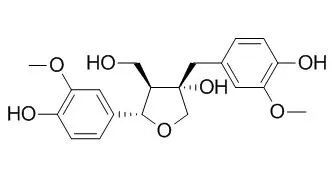| In vitro: |
| J Agric Food Chem. 2014 Jan 8;62(1):144-51. | | Radical-scavenging compounds from olive tree (Olea europaea L.) wood.[Pubmed: 24328093] | The purpose of this study was to complete knowledge on the chemical composition and radical-scavenging activity of olive tree wood.
METHODS AND RESULTS:
Two new monoterpene glycosides, (-)-oleuropeic acid 6'-O-α-D-glucopyranosyl ester (6a) and (-)-perillic acid 1'-O-β-D-primeverosyl ester (8), together with the known compounds (-)-oleuropeic acid (1), (-)-Olivil (2), the aldehydic form of oleuropein aglycone (3), (+)-1-hydroxypinoresinol 1-O-β-D-glucopyranoside (4), (-)-oleuropeic acid 1'-O-β-D-glucopyranosyl ester (5), (-)-oleuropeic acid 6'-O-β-D-glucopyranosyl ester (6b), and (-)-Olivil 4-O-β-D-glucopyranoside (7) were isolated from an ethyl acetate extract. The radical scavengers found (2-4 and 7) were detected and isolated with the help of the online HPLC-DAD-DPPH/ABTS technique.
CONCLUSIONS:
Compounds 2-4 and 7 displayed a higher antioxidative effect against the free radical DPPH than the reference BHT and lower than hydroxytyrosol, whereas compounds 1, 5, 6a, 6b, and 8 showed no activity. | | Biosci Biotechnol Biochem. 2003 Feb;67(2):415-9. | | (-)-olivil and (+)-1-acetoxypinoresinol from the olive tree (Olea europaea Linne; Oleaceae) as feeding stimulants of the olive weevil (Dyscerus perforatus).[Pubmed: 12729011] |
METHODS AND RESULTS:
Guided by a feeding stimulant activity test on the olive weevil (Dyscerus perforatus), two compounds that showed potent feeding stimulant activity were isolated from the olive tree (Olea europaea).
Based on their spectral data and a literature survey, they were identified as (-)-Olivil (1) and (+ )-1-acetoxypinoresinol (2).
CONCLUSIONS:
The activities of these minor lignans were significantly higher for the female than for the male weevil. |
|






 Cell. 2018 Jan 11;172(1-2):249-261.e12. doi: 10.1016/j.cell.2017.12.019.IF=36.216(2019)
Cell. 2018 Jan 11;172(1-2):249-261.e12. doi: 10.1016/j.cell.2017.12.019.IF=36.216(2019) Cell Metab. 2020 Mar 3;31(3):534-548.e5. doi: 10.1016/j.cmet.2020.01.002.IF=22.415(2019)
Cell Metab. 2020 Mar 3;31(3):534-548.e5. doi: 10.1016/j.cmet.2020.01.002.IF=22.415(2019) Mol Cell. 2017 Nov 16;68(4):673-685.e6. doi: 10.1016/j.molcel.2017.10.022.IF=14.548(2019)
Mol Cell. 2017 Nov 16;68(4):673-685.e6. doi: 10.1016/j.molcel.2017.10.022.IF=14.548(2019)